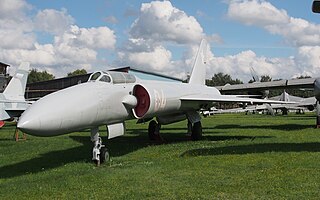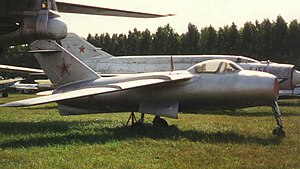
Artem (Artyom) Ivanovich Mikoyan was a Soviet Armenian aircraft designer, who cofounded the Mikoyan-Gurevich design bureau along with Mikhail Gurevich.

The Rolls-Royce RB.41 Nene is a 1940s British centrifugal compressor turbojet engine. The Nene was a complete redesign, rather than a scaled-up Rolls-Royce Derwent, with a design target of 5,000 lbf (22 kN), making it the most powerful engine of its era. First run in 1944, it was Rolls-Royce's third jet engine to enter production, and first ran less than 6 months from the start of design. It was named after the River Nene in keeping with the company's tradition of naming its jet engines after rivers.

The Sukhoi Su-9 was an early jet fighter built in the Soviet Union shortly after World War II. The design began in 1944 and was intended to use Soviet-designed turbojet engines. The design was heavily influenced by captured German jet fighters and it was subsequently redesigned to use a Soviet copy of a German turbojet. The Su-9 was slower than competing Soviet aircraft and it was cancelled as a result. A modified version with different engines and a revised wing became the Su-11, but this did not enter production either. The Su-13 was a proposal to re-engine the aircraft with Soviet copies of the Rolls-Royce Derwent turbojet as well as to modify it for night fighting, but neither proposal was accepted.

The Yakovlev Yak-23 was an early Soviet jet fighter with a straight wing. It was developed from the Yak-17 in the late 1940s and used a reverse-engineered copy of a British engine. It was not built in large numbers as it was inferior in performance to the swept-wing Mikoyan-Gurevich MiG-15. Many Yak-23s were exported to the Warsaw Pact nations and remained in service for most of the 1950s, although some were still in use a decade later.

The Yakovlev Yak-17 was an early Soviet jet fighter. It was developed from the Yak-15, the primary difference being tricycle landing gear. The trainer version, known as the Yak-17UTI, was the only Soviet jet trainer of the 1940s. Both aircraft were exported in small numbers and the Yak-17 was soon replaced by the far superior Mikoyan-Gurevich MiG-15 beginning in 1950.

The Yakovlev Yak-19 was a prototype Soviet fighter built in the late 1940s. It was the first Soviet aircraft to be equipped with an afterburning turbojet, the Klimov RD-10F that was derived from the German Jumo 004 engine. Only two examples were built as it was rejected for service by the Soviet Air Force.

The Rolls-Royce RB.37 Derwent is a 1940s British centrifugal compressor turbojet engine, the second Rolls-Royce jet engine to enter production. It was an improved version of the Rolls-Royce Welland, which itself was a renamed version of Frank Whittle's Power Jets W.2B. Rolls-Royce inherited the Derwent design from Rover when they took over their jet engine development in 1943.

The Klimov VK-1 was the first Soviet jet engine to see significant production. It was developed by Vladimir Yakovlevich Klimov and first produced by the GAZ 116 works. Derived from the Rolls-Royce Nene, the engine was also built under licence in China as the Wopen WP-5.

The Yakovlev Yak-25 was a Soviet military aircraft, an early turbojet-powered fighter aircraft designed by the Yakovlev OKB. The designation was later reused for a different interceptor design. Tasked by the Council of Ministers in a directive issued on 11 March 1947, with producing a straight winged fighter similar to the earlier Yak-19, but powered by a Rolls-Royce Derwent V, OKB-115 swiftly produced the Yak-25, which blazed several trails as the first Soviet fighter with a fully pressurised cockpit, air conditioning, jettisonable canopy, and hydraulic airbrakes on the fuselage amongst other innovations.

The Klimov RD-500 was an unlicensed Soviet copy of the Rolls-Royce Derwent V turbojet that was sold to the Soviet Union in 1947. The Klimov OKB adapted it for Soviet production methods and materials.

The Lavochkin La-250 "Anakonda" was a high-altitude interceptor aircraft prototype developed in the Soviet Union by the Lavochkin design bureau in the 1950s. Its nickname "Anaconda" was invented during the flight test and referred to both the elongated body shape as well as the relatively critical flight characteristics of the machine.
The JSC Klimov presently manufactures internationally certified gas turbine engines, main gearboxes and accessory drive gearboxes for transport aircraft.

The Fokker S.14 Machtrainer is a two-seater military training jet aircraft designed and manufactured by the Dutch aircraft manufacturer Fokker for the Royal Netherlands Air Force (RNLAF). It has the distinction of being one of the first dedicated jet-powered training aircraft to be produced in the world. The unarmed trainer served with Dutch Air Force for 12 years, and one prototype was used by the Dutch Aerospace labs for 6. Two were lost in air crashes, one in 1955 and a second in 1964. The Machtrainer features side-by-side seating with a single engine, although an under-belly gun pod and hardpoints were designed but not put into use.

Yakovlev Yak-50 was an early experimental turbojet interceptor aircraft designed in 1948 by the Yakovlev OKB in the USSR. The aircraft was essentially a stretched version of the Yakovlev Yak-30 (1948), with a more powerful engine and greater wing sweep. The Yak-50 is perhaps most significant as the first Yakovlev aircraft equipped with velosipednoye (bicycle) landing gear, a trademark of later Yakovlev designs. The Yak-50 designation was later reused for a propeller-driven aerobatic and trainer aircraft.

The Tupolev Tu-12 was an experimental Soviet jet-powered medium bomber developed from the successful piston-engined Tupolev Tu-2 bomber after the end of World War II. It was designed as an interim aircraft to familiarize Tupolev and the Soviet Air Forces (VVS) with the issues involved with jet-engined bombers.

The Lavochkin La-152,, and its variants, was a jet fighter prototype designed and manufactured by the Lavochkin Design Bureau (OKB) shortly after the end of World War II. Derived from the Lavochkin La-150, the 152 used several different engines, but the program was canceled as other fighters with more powerful engines and swept wings showed more promise.
The Lavochkin La-168 was a jet fighter developed for the USSR. Like the better known Mikoyan MiG-15 which was ultimately selected and went on to become one of the most successful jet fighters of its era, the Lavochkin La-168 was designed in response to a 1946 request for an advanced swept-wing jet fighter capable of transonic performance. It was to use new turbojet based on the Rolls-Royce Nene in competition with the design bureaus of Artem Mikoyan and Mikhail Gurevich, and Aleksandr Yakovlev. A scaled down version of this aircraft would lead to the production of the La-15, which performed well but would be dropped in favor of the MiG-15.
The Alekseyev I-212 was a twin-engined, jet fighter designed in the USSR in 1947 at OKB-21. It was a two-seat variant of the I-21 designed in response to a requirement for a very long-range fighter issued by the Voenno-Vozdushnye Sily (VVS),, in 1946. Intended as an escort fighter, it was also designed for use as a night fighter and reconnaissance aircraft. No prototype was built, although some parts may have begun building before the project was completed.

The Mikoyan-Gurevich I-320 was a prototype Soviet long-range all-weather interceptor aircraft of the late 1940s-early 1950s. Only two were made, with no production following.

The Tupolev '73',, was a Soviet trijet medium bomber of the late 1940s. It lost out to the Ilyushin Il-28 'Beagle'.



















